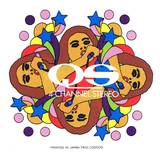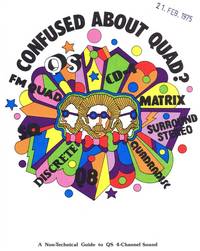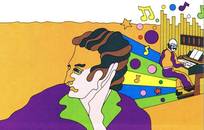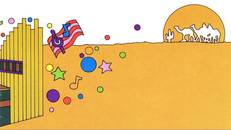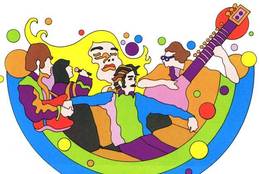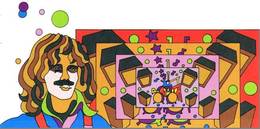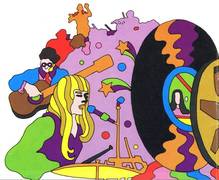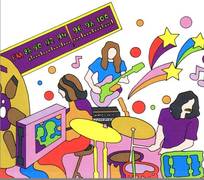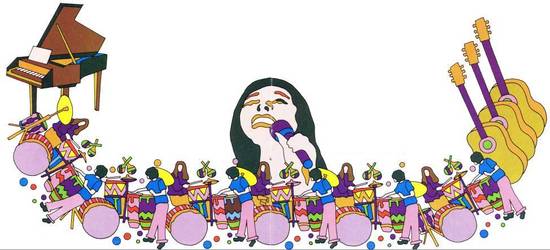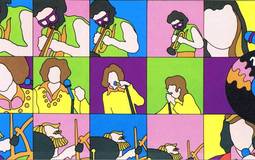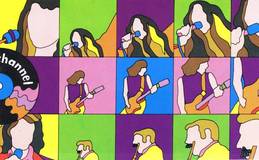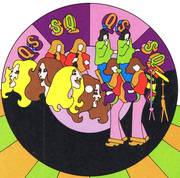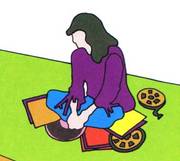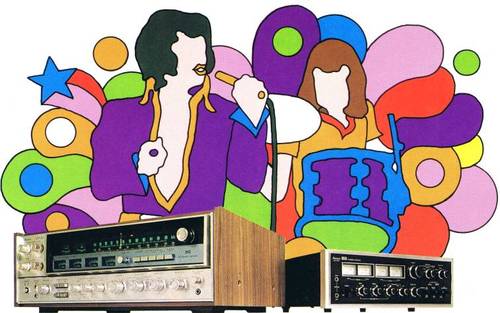1975 wurden die Zeiten für die Quadro Anbieter härter
Auf einmal mußten die drei Quadro-Anbieter auf die jeweils anderen beiden Systeme hinweisen, weil das Wegblenden oder Ignorieren zu soviel Verwirrung und Frust geführt hatte, daß die Kunden voller Unverständnis einfach gar nichts mehr gekauft hatten.
Auch wurde merkwürdigerweise ganz plötzlich erkannt, daß ja die Schallpatten, die verfügbaren kaufbaren Quellen überhaupt, der Anreiz zum Kauf einer Quadroanlage waren, nicht die chromblitzenden Frontplatten mit den vielen Knöpfchen und Schaltern.
.
SANSUI als einer der großen japanischen "Player" auf dem Quadro-Markt und ohne eigene Schallplattenfirma mußte etwas tun, zumindest aus der (bescheidenen) Erfahrung der letzen 4 Jahre lernen. Und so enstand 1975 dieses Heftchen.
.
1975 - Confused about QUAD ? A Non- Technical Guide to QS 4-Channel Sound
.... erschienen vermutlich zur Winter CES in Chicago und dann weltweit verteilt.
Picture yourself listening to a pipe organ in the middle of an open desert. You don't have to be an acoustical engineer to sense that something is very seriously wrong. The rich overtones of the instrument - the subtle blendings of its deep bass voice and bell-like upper register - vanish into thin air.
Let's put you and the organ back in the concert hall or cathedral. Presto - the full body and timbre of the sound is restored.
.
Why the difference?
One simple concept says it all: SOUND FIELD. Direct sounds and ambient sounds are needed to create a sound field. The majority of the sounds you hear in a proper acoustical setting are ambient sounds (umgebende Töne/Klänge)- reflected from walls and ceiling before they reach your ears.
- Anmerkung : Den Begriff "Sound Field" mixen die Amerikaner kreuz und quer sowohl für Klang-Feld als auch für das plastische Stereo-Feld gleichermaßen. Es gibt keine trennende vernünftige unterscheidende Übersetzung für "Sound-Field".
.
Die Orgel in der Wüste .......
In our organ-in-the-desert example all sounds you heard were direct. They went right past your ears and kept on going. You got no ambient sound (keine Reflektionen), thus no sound field. In hi-fi you face exactly the same problem.
.
Monophonics gave you one point of sound with no ambience (even with "echo" added or when played through a multiple of speakers).
Stereo-phonics gave you two points of sound. This allowed the introduction of direction (i.e. "left" and "right") and some ambience. But all this was crammed into one flat wall of sound in your living room. The dimension of a real sound field was still very obviously missing.
That's why you need more than 2-channel stereo. And that's the reason behind 4-channel. It's that simple.
.
SOUND FIELD REALISM
Every musical instrument, including the human voice, is designed to enlarge and shape the sounds it creates. Since these sounds are created in real space, they have dimension as well as tone and musicality. The combination of dimension, tone and musicality adds up to realism.
To recreate real sound dimension properly via electronic recordings you must record - and play back - from a multiple number of points. Simple geometry shows that four separate points of playback - and four channels to deliver all these different sounds to the right places - are the most practical and efficient.
In a 4-channel sound field, ambient sounds appear to come from all around you while the direct sounds come from the directions in which they originated.
Listen carefully to a 4-channel recording of a full orchestra or even a solo instrument. Then switch to stereo or mono and back to 4-channel again. The meaning of the word "realism" comes through loud and clear.
- Anmerkung : Und hier sind wir beim Grundproblem, welches der Autor des Heftchens bislang versteckt hatte : "listen carefully" - lausche angestrengt bzw. sorgfältig ...... und genau das hatte mich damals davon wieder abgebracht, es war nach wenigen Minuten anstrengend und eben nicht "erholsam".
.
THE CREATIVE SPARK
A few early 2-channel stereo recordings used the "ping pong" effect to run steam locomotives across your living room wall. But such stereo classics as The Beatles' "Sgt. Pepper" and others in the rock and pop music fields were among the first to use the element of space as a musical building block along with harmony, rhythm and melody.
But that was just a beginning.
Artists who are creating 4-channel recorded music today - and that includes practically everybody in the classics, pop and rock, folk and all other kinds of music - are finding it easy and fun to apply the concept of space to music because they have a full 4-channel sound field at their disposal.
In addition to the "concert hall realism" of 4-channel, they also have the ability to place any sound where they please in the 360° sound field which surrounds you.
Sound field dimension is not just a plaything for the avant garde. The creative opportunities offered by 4-channel are being productively explored by serious classical conductors and contemporary composers alike.
The 4-channel sound field allows them to open up their music so that you can dive in for some real creative listening enjoyment right in your own home.
.
4-CHANNEL RECORDS, TAPES & FM BROADCASTS
Everyone wants to know what kind of music they can hear in 4-channel today. And the answer is simple - nearly everything.
Listeners whose tastes might range from Tchaikovsky to Chacksfield or from Santana to B.B. King to The Carpenters are finding that these and hundreds of other artists and composers sound not only better but entirely fresh and different in 4-channel.
Record companies all over the world are selling literally hundreds of thousands of 4-channel records and tapes in every conceivable category of music.
- Anmerkung: Selbst in 1975 war das mit den tausenden von Quadro-PLatten weidlich übertrieben. Es waren am Ende mehrere hundert Titel, die in Quadro gepreßt wurden, aber insgesamt für alle 3 Quadro-Verfahren.
FM broadcasters, too, are beginning to provide up to 100% of their programs in 4-channel to millions of listeners. Naturally, all of these 4-channel sources can be heard in conventional stereo or mono, too.
- Anmerkung : Hören ja, aber mit deutlichen Einbußen an Klangqualität, bei FM-Mono sogar mit erheblichen Auslöschungen.
There are only two kinds of 4-channel - matrix and discrete. And there are only three basic types of 4-channel media - disc, tape and FM broadcasts. That's simple enough, isn't it?
Brand names include QS, SQ, CD-4 (or Quadradisc - RCA), Q-8 (8-Spur Kassetten), and about a dozen other less important ones. Each one in its own way is trying to give you the best 4-channel sound possible.
QS 4-CHANNEL
Any good 4-channel recording must provide the highest possible fidelity and musicality when played on your home 4-channel equipment.
- Anmerkung : Es wird hier schlichtweg verheimlicht, daß bei dem angeblich perfekten CD-4 System der Frequenzumfang bei Platte und Test-Rundfunk ganz knapp über 13 kHz liegt und bei den QS/SQ Matrix - Systemen die Kanaltrennung sehr sehr bescheiden war.
.
Not just some of the time, but from moment to moment throughout the recording. Such all-important qualities as separation, tonality, signal-to-noise ratio, constant gain (volume) and many other technical aspects are not luxuries. They are absolutely essential to good 4-channel sound.
.
QS 4-channel guarantees that each of these requirements is met. Always.
A record artist or producer making a 4-channel recording might want to strive for absolute sound field fidelity to an original "concert hall" performance. Or he might want to use the creative opportunity of 4-channel to produce his own distinctive 4-channel sound. In all cases he must be positive that you get out of the recording exactly what he puts into it. No more, no less.
Let's say he wants the sound of a vocalist to come trom the exact middle of the 4-channel sound field. He also wants a rhythm section spread softly but distinctly over the back channels and a piano located at the front left. Each of these sounds must be recreated through a delicate combination of sound elements coming from all four of your speakers in different amounts at different times.
He must insist that no sound image is accidentally lost in the shuffle or allowed to waver in volume or position. Very few 4-channel systems can guarantee the effects he wants.
Discrete 4-channel tape is one. The QS matrix is another.
Since the discrete 4-channel tape format is popular only among a relatively few hi-fi fans due to the high cost of playback equipment and the inconvenience it can cause, record companies invariably try to release the majority of their 4-channel material on matrix discs.
More and more record artists and producers are finding that a disc encoded with QS affords the same separation, high fidelity and musicality as discrete tape when played back on a QS decoder in your home. Record companies also know that a QS disc is fully compatible with stereo and mono equipment - a very important factor in record sales.
- Anmerkung : Schon wieder gelogen, die echten Quadro Platten QS, SQ oder CD-4 waren nie "fully compatible" zu Stereo oder gar Mono und schon gar nicht mit einem Stereo Abtaster abspielbar.
From the 4-channel listener's point of view, QS has two additional bonus features: QS equipment does a perfect job of decoding all other matrix-encoded discs as well, including SQ.
Then, with truly startling effectiveness, the QS Synthesizer built into all QS equipment has the seemingly magical ability to play conventional stereo records with very effective 4-channel sound field effects.
- Anmerkung : Der Unterschied einer Quadro-Platte auf dem Stereo-Plattenspieler zu einer gleichen Stereo-Platte auf dem gleichen Plattenspieler war ganz deutlich - auch für Laien - wahrzunehmen.
.
IS THE QS SYNTHESIZER A GIMMICK?
Until you actually hear it work, you may think the idea of getting real 4-channel sound out of ordinary 2-channel records is just a trick.
But in fact, 2-channel stereo is the gimmick. It tries to fool your ears by crowding all the subtle and complex sounds of a real sound field into the flat "wall of sound" created by your two speakers.
.
When a recording artist makes a stereo record, all the sounds he creates are picked up by the multi-channel recording equipment in the studio or concert hall. Then, all those sounds must be compressed into a 2-channel recording.
When you play such a recording in 2-channel stereo out of only two speakers, you hear only the most obvious, most superficial parts. The 2-channel format tends to "hide" the rest.
Odds are that nine out of ten stereo recordings you own - or that you hear over FM stereo - will produce dimensional 4-channel sound when properly synthesized through four speakers in a 4-channel sound field system.
QS is the ONLY 4-channel system with an effective synthesizer to perform this with real 4-channel separation, fidelity and musicality.
The QS Synthesizer gives these "hidden sounds" startling new shape and dimension within your 4-channel sound field. It's a whole new art of sound reproduction. Still not convinced? Just try it for yourself - with your own 2-channel sounds. It's no gimmick.
.
- Anmerkung : Zum Beginn der Computerzeit hatte ich mir den YAMAHA 5+1 (7+1) DSP-1000 Zusatz gekauft, der irgendwie bis zu 21 solcher angeblich unverzichtbaren Klangfelder mit einem digitalen Signalprozessor erzeugen konnte. Es war nur noch anstrengend.
.
QS PLAYS SQ
Leonard Bernstein. - Andy Williams. - Santana. - Blood, Sweat & Tears.
These and other SQ artists are in 4-channel now. QS lets you enjoy them all. QS decodes SQ 4-channel sources all by itself at no additional expense to you. And QS does it with excellent 4-channel separation. QS... SQ... Remember that QS decodes both.
.
WHAT TO LOOK FOR IN 4-CHANNEL EQUIPMENT
So maybe we've sold you on the idea of 4-channel sound. Now what should you look for in 4-channel equipment for your home?
Your 4-channel set-up should be able to play as many different 4-channel music sources as possible - QS, SQ and all the other matrix-encoded records, tapes and FM broadcasts. You will probably want to include one or more discrete sources, too, such as Q-8, Surround Stereo and other kinds of tape, plus the so-called discrete CD-4 (or Quadradisc) records.
If you have a big investment in 2-channel records (or tapes) as most hi-fi fans do, you should look for a synthesizer to effectively convert these sources (and FM stereo, too) into good 4-channel sound.
Any 4-channel instrument you buy must have the ability to deliver the two essential qualities of high fidelity and musicality if you are to enjoy the benefits of a real 4-channel sound field in your home.
Is there one kind of 4-channel equipment which gives you all these advantages? You've guessed the answer and you're right. Look for 4-channel equipment - regardless of brand - which incorporates QS. It's that easy.
QS SYSTEM 4-CHANNEL EQUIPMENT
QS 4-channel sound is available today in a wide selection of products from Sansui. Outstanding 4-channel performance, maximum flexibility for handling all types of 4-channel sources, the QS Synthesizer, and maximum versatility in all 4-channel control features such as four professional VU meters, sophisticated balance, tone and function controls, "Concert Hall" and "Surround" reproduction modes for QS regular matrix and QS Synthesizer, and strictly high fidelity, pre- and power amplifier qualities ... all these and more are yours in each and every Sansui 4-channel receiver, amplifier and rear channel (add-on) amplifier.
.
Your dealer can fill you in on the details on these and other Sansui QS System-equipped 4-channel models today.
Die geschützten Warenzeichen sind :
.
- QS TM SANSUI ELECTRIC CO., LTD.
- SQ TM CBS INC.
- CD-4 TM JVC
- QUADRADISC AND Q-8 TM RCA RECORDS
- SURROUND STEREO TM VANGUARD RECORDS
.
SANSUI ELECTRIC CO., LTD. 14-1, 2-CHOME, IZUMI, SUGINAMI-KU, TOKYO 168, JAPAN TELEPHONE: 323-1111 TELEX: 232-2076
SANSUI ELECTRONICS CORPORATION 55-11 QUEENS BLVD. WOODSIDE, NEW YORK 11377, U.S.A. TELEX: NEW YORK 422633 SEC UI
SANSUI AUDIO EUROPE S. A. DIACEM BUILDING, VESTINGSTRAAT 53-55, 2000 ANTWERP, BELGIUM TELEX: ANTWERP 33538
.
Das war ein SANSUI Heftchen aus Januar 1975
.

